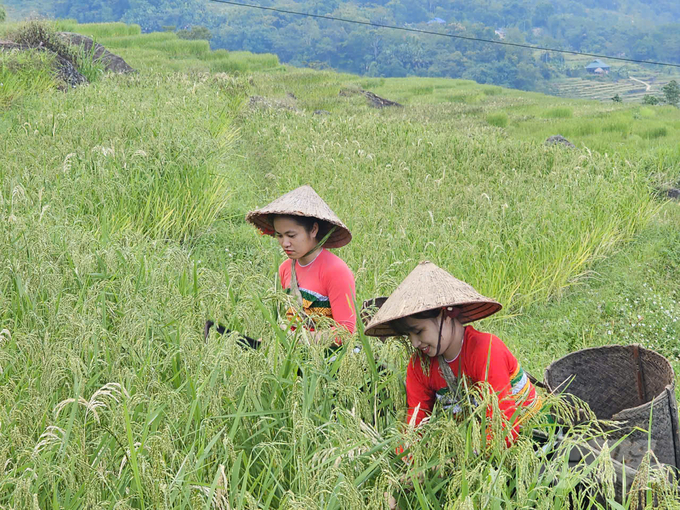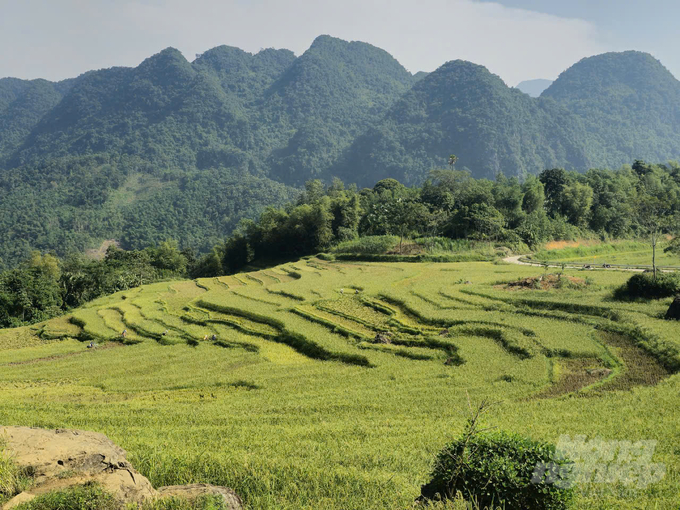May 21, 2025 | 03:38 GMT +7
May 21, 2025 | 03:38 GMT +7
Hotline: 0913.378.918
May 21, 2025 | 03:38 GMT +7
Hotline: 0913.378.918
Thanh Hoa currently has over 648,000 hectares of forests and forest land. The province's forest ecosystem is highly diverse, home to many rare species of animals and plants.
Capitalizing on this advantage, Thanh Hoa has implemented several solutions in recent years to promote the development of community-based and eco-tourism, which are linked to forest protection. This has helped many local people increase their income, significantly contributing to poverty alleviation in mountainous areas.

Pu Luong tourism area, famous for its stunning landscape. Photo: Quoc Toan.
In Ba Thuoc district, the Pu Luong - Cuc Phuong Biodiversity Conservation Project, initiated in 2002 by the international wildlife conservation organization FFI, has supported households in 10 villages in the buffer zone of Pu Luong Nature Reserve to engage in tourism. To date, Ba Thuoc district has more than 100 accommodation facilities, mostly homestays and resorts, concentrated in Thanh Lam, Thanh Son, and Co Lung communes.
In recent years, the number of tourists visiting Ba Thuoc has steadily increased. By September 2024, the total number of visitors had reached over 259,000, with nearly 50,000 being international tourists. Tourism activities have generated over VND 560 billion in revenue.

Pu Luong impresses visitors with its pristine beauty, including dense primeval forests and terraced rice fields. Photo: Quoc Toan.
Ms. Lo Thi Hoai, owner of a homestay in Bang village, Thanh Son commune, and leader of the Thanh Son community tourism group, shared: “Relying on the forest for community-based and eco-tourism has raised awareness and income for the villagers. Many young people no longer have to leave the village to seek work elsewhere; instead, they are employed at local accommodations. The community's agricultural products now have stable markets, and many families in the village have escaped poverty."

Stilt houses in Pu Luong were renovated into tourist accommodations. Photo: Quoc Toan.
Additionally, Thanh Hoa is home to Ben En National Park and part of Cuc Phuong National Park, as well as several nature reserves including Xuan Lien, Pu Hu, Nam Dong, Sen Tam Quy, eight protective forest management boards, and 11 scenic, cultural, and historical conservation sites. Each forest area in the province has its unique strengths for tourism development.
Currently, the province has over 30 eco-tourism areas, with some attracting large numbers of tourists, such as Ben En National Park, which receives around 30,000 visitors annually, generating over VND 1 billion in revenue. Other nature reserves like Xuan Lien and Pu Hu, as well as forest management boards in Lang Chanh, Ham Rong - Nui Do, Truong Le, An Tiem, Lam Kinh historical site, Sen Tam Quy forest, and eco-tourism sites in mountainous districts also welcome thousands of visitors each year for tours and experiences.

Pu Luong attracts tourists for sightseeing and experiences. Photo: Quoc Toan.
According to Mr. Trinh Quang Tuan, Head of the Nature Conservation Department (Thanh Hoa Forest Protection Sub-Department), to develop eco-tourism and community-based tourism linked to forest protection, Thanh Hoa is currently refining its policies to manage and encourage investment in eco-tourism and green tourism, with a focus on sustainable development.
Over the past years, the Forest Protection Sub-Department has worked with local authorities, forest management boards, and state-owned forest owners to promote awareness campaigns about compliance with the Forestry Law, forest protection, and development, while maintaining the environment, safeguarding biodiversity, and raising awareness among residents and tourists.
Translated by Kieu Chi

(VAN) Japan's grant aid project contributes to capacity building, promoting organic agricultural production, and fostering sustainable community development in Dong Thap province.

(VAN) For years, the CRISPR-Cas9 genome technology has been reshaping genetic engineering, a precision tool to transform everything from agriculture to medicine.

(VAN) Vietnam aims to become a 'leader' in the region in the capacity and managing effectively soil health and crop nutrition.
![Reducing emissions from rice fields: [Part 1] Farming clean rice together](https://t.ex-cdn.com/nongnghiepmoitruong.vn/608w/files/news/2025/05/05/z6509661417740_a647202949c539012a959e841c03e1d3-nongnghiep-143611.jpg)
(VAN) Growing clean rice helps reduce environmental pollution while increasing income, allowing farmers to feel secure in production and remain committed to their fields for the long term.
/2025/05/19/5136-1-144800_230.jpg)
(VAN) The Nghe An Provincial People's Committee has just approved the list of beneficiaries eligible for revenue from the Emission Reductions Payment Agreement (ERPA) in the North Central region for the year 2025.

(VAN) 14 out of 35 domesticated elephants in Dak Lak province have had their living conditions improved, with 11 of them currently participating in the non-riding elephant tourism model.

(VAN) Muong Nhe Nature Reserve hopes that being upgraded to a national park will lay the foundation for forest protection efforts to be carried out in a systematic, modern, and sustainable manner.